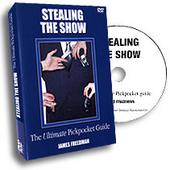Stealing The Show
James Freedman
(Based on 1 review)

Reviews
(Top ▲)
When I received this DVD for review, I almost refused it on the grounds that I know absolutely nothing about pickpocketing. Then it occurred to me that I am precisely the demographic to which the DVD caters. Indeed, based on my initial response, I might even be a little dumber than its target market, so who better to challenge Mr. Freedman's teaching techniques.
James Freedman's Stealing The Show is a complete guide to picking pockets, from A to Z, from coats to pants, from pens to wallets, etc. He starts us off with the very basics -- i.e. How to Practice, Where To Pick Pockets, Types of Steals, etc. -- then he goes on to explore actual methods for picking pockets, providing several techniques for each pocket, which are selectively employed according to both performing conditions and your intention when executing the steal (i.e. do I want the audience to see this as I do it, or do I want to reveal the fact that I've stolen the item later).
Every technique is discussed, explained, then shown in action at a live show, executed flawlessly and much to the surprise of the participating spectators. In addition, James teaches you how to remove watches, ties, cufflinks, belts, suspenders and even glasses (this last one is great). Every one of these is as much a lesson in misdirection as it is in pickpocketing, employing advanced spectator management to affect bold yet subtle steals. Moreover, while this DVD deals primarily with mechanics, seeing the moves in performance gives one a sense of the theater of pickpocketing.
There are some seminal books on this subject, including The Complete Course in Pickpocketing by Pierre Jacques, and Theatrical Pickpocketing by Jim Ravel, but none that couldn't have benefited from visual aids. If you're interested in adding pickpocketing to your act, I can't imagine a better investment than this. It's one of the best instructional DVDs I have ever come across in magic. I have only one caveat. James Freedman is an enormously comfortable (and, if I may say, congenial) performer, and that also comes through in his teaching. As a result, one might be lulled into a sense that what he is doing is easy. It certainly looks easy, both when he is performing the material for real people, and when he is teaching the techniques using a dress-dummy. However, that ease is borne of thousands of performances, so don't be fooled as you're watching -- this man works hard to make it look easy!
David Acer
James Freedman's Stealing The Show is a complete guide to picking pockets, from A to Z, from coats to pants, from pens to wallets, etc. He starts us off with the very basics -- i.e. How to Practice, Where To Pick Pockets, Types of Steals, etc. -- then he goes on to explore actual methods for picking pockets, providing several techniques for each pocket, which are selectively employed according to both performing conditions and your intention when executing the steal (i.e. do I want the audience to see this as I do it, or do I want to reveal the fact that I've stolen the item later).
Every technique is discussed, explained, then shown in action at a live show, executed flawlessly and much to the surprise of the participating spectators. In addition, James teaches you how to remove watches, ties, cufflinks, belts, suspenders and even glasses (this last one is great). Every one of these is as much a lesson in misdirection as it is in pickpocketing, employing advanced spectator management to affect bold yet subtle steals. Moreover, while this DVD deals primarily with mechanics, seeing the moves in performance gives one a sense of the theater of pickpocketing.
There are some seminal books on this subject, including The Complete Course in Pickpocketing by Pierre Jacques, and Theatrical Pickpocketing by Jim Ravel, but none that couldn't have benefited from visual aids. If you're interested in adding pickpocketing to your act, I can't imagine a better investment than this. It's one of the best instructional DVDs I have ever come across in magic. I have only one caveat. James Freedman is an enormously comfortable (and, if I may say, congenial) performer, and that also comes through in his teaching. As a result, one might be lulled into a sense that what he is doing is easy. It certainly looks easy, both when he is performing the material for real people, and when he is teaching the techniques using a dress-dummy. However, that ease is borne of thousands of performances, so don't be fooled as you're watching -- this man works hard to make it look easy!
David Acer


